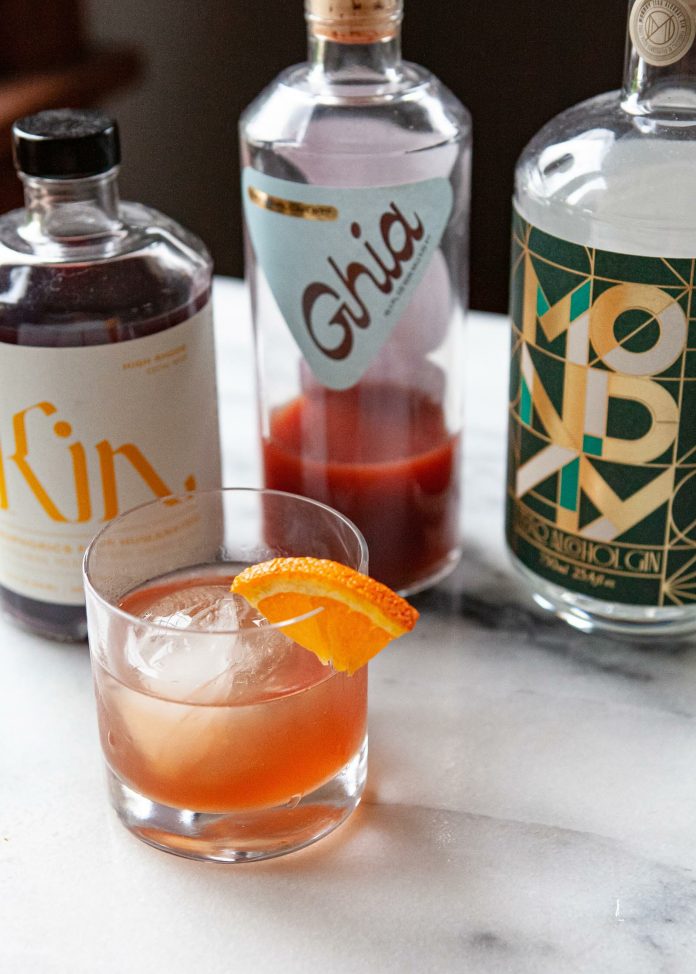[ad_1]
Until recently, the world of mocktails was a small (and appropriately maligned) one: you could have a club soda or tonic sparkler, a shrub to pucker the mouths of the vinegar-inclined, or try and fail at a recipe so complex you’d drink a case of LaCroix before you tried it again.
Oh how things change: in just a few years we’ve gone from sussed-up Shirley Temples to entire shelves of zero-alcohol spirits that are well worth having in any bar.
Even better? Research suggests that non-alcoholic drinks can trigger a similar release of dopamine for a complex, elevated experience (otherwise known as a buzz), with none of the drawbacks.
What Makes a Good Non-Alcoholic Liquor?
There are two standouts in this new world of NA or non-alcoholic drinks:
- Base spirits you can build entire drinks around (much like their alcoholic models)
- Sippable mixers compelling enough to stand on their own
Some NA spirits are simple infusions – botanicals steeped in water – while others are fully fermented before being distilled and having the alcohol removed.
What do all of them have in common? They’ve had to figure out the viscosity (or mouthfeel) and the finish (that “burn” or lingering bitterness that follows alcohol).
When they do, you have something more than yesteryear’s sad little mixers on your hands; you have legitimate substitutes for alcohol!
How to Build a Non-Alcoholic Cocktail
For a mocktail to have the complexity and feel of alcohol, all of its flavors, textures and finish have to work together.
The viscosity, or sense of substance, to the base spirit should let you know you’re drinking something more substantial than a bit of bitter water.
Fortunately, most of the top shelf alternatives listed here do this well and offer nuanced notes that don’t just disappear off the tongue.
Harder to compensate for is the finish of alcohol, that burn that follows each sip for an appreciable amount of time. Most worthy non-alcoholic alternatives rely on bitterness for that lingering burn at the back of the tongue, which… works.
To make a mocktail, do the following:
- Start with one of the base spirits (Monday Zero Alcohol Gin or Ritual Tequila Alternative)
- Pair in a 2:1 ratio with one of the vermouth-like modifiers (Ghia, Seedlip Spice 94, Lyre’s Italian Orange, Curious Elixirs No. 1) – so, two parts base spirit to one part vermouth-like modifier
- Add in smaller amounts of any other accents as you feel inspired!
The Best Non-Alcoholic Base Spirits
Monday Zero Alcohol Gin, $39.99
Monday’s elegant, bracing bitter and herbal balance make for a surprisingly capable gin substitute.
Subtle aromatics greet you first, with cucumber and juniper somewhere in the mix, but the long, semi-bitter finish is one of the best approximations for a London Dry gin you’ll find.
The beautiful, embossed, Art Deco-inspired label looks alluring on the shelf, too. Monday Zero works especially well in a NAgroni.
Ritual Tequila Alternative, $26.99
Ritual’s tequila alternative (like its gin and whiskey) has more heat than it does bitterness, a peppercorn finish that in the right cocktail perfectly mimics the burn of boozy tequilas.
The botanicals are still subtle, but Ritual is anything but subtle when it comes to that heat.
Try Ritual in a NA Mexican Mule, a bright, spicy sipper with a decent kick.
The Best Non-Alcoholic Sippable Mixers and Bitters
Ghia, $33
A fascinating aperitif (rather than a base spirit alternative), Ghia is a medium-bodied and somewhat heady bouquet of gentian, fig, elderflower, and rosemary, stimulating and soothing all at once.
Ghia somehow marries the herb-forward qualities of Chartreuse to the baritone voice of a vermouth like Carpano Antica. Combined with a base spirit (like Monday’s gin alternative), it brings both taste and body to a cocktail.
Enjoyed on its own it’s a kissing cousin to the bitter aperitivi of Italy.
Seedlip Spice 94, $32
A bright but herbal spirit, Seedlip’s Spice 94 is a gin substitute with more subtlety and complexity than its tasting notes would suggest.
Because the spicing – cardamom, Allspice, grapefruit, and bark – is restrained and balanced, the experience is rather calming.
You can more easily go off-script with Seedlip than most mixers, and more readily and frequently enjoy it on its own than you could a more basic base spirit.
Lyre’s Italian Orange, $35.99
Lyre’s offers the most complete line of liquor alternatives, including malt whiskeys, London Dry gins, a coffee “liqueur”, a rum, and aperitifs. They are all well-crafted, but with subtle flavors that can be either frustrating or perfect.
Lacking either the spicy finish of Ritual or the long bitter finish of Monday, Lyre’s NA spirits are more inspired by their boozy originals rather than trying to mimic them outright.
Lyre’s Italian Orange is in the spirit of Campari, but much less bitter and heavy, a drier balance of blood orange and maraschino that can also be used as an orange liqueur substitute.
Stirrings Blood Orange Bitters, $4.99
As bitters are indispensable to any cocktail bar, so too Stirrings Blood Orange Bitters should be an essential part of a home mocktail bar.
Less intense than standard bitters like Angostura or Regan’s Orange Bitters, Stirrings walks the line between being a true mixer and a dash-at-a-time accent to a drink.
Add up to an ounce at time to a NAgroni-type mocktail or combine with club soda and a spirit like Seedlip (or just muddled fruit) for a refreshing highball.
Curious Elixirs (all five recipes/bottlings) are closer to pre-mixed cocktails than substitutes for individual spirits or vermouths. While they work best on their own, they can also be mixed with other spirits.
The No. 1 is similar to a Negroni, blood-red and bitten by bitter orange, while No. 3 is like a Cucumber Collins, lighter and brighter.
They don’t have the “burn” or any other finish akin to alcohol, which may be their one downside: They simply dissipate too quickly, though they’re certainly enjoyable in the passing.
[ad_2]
Source link















